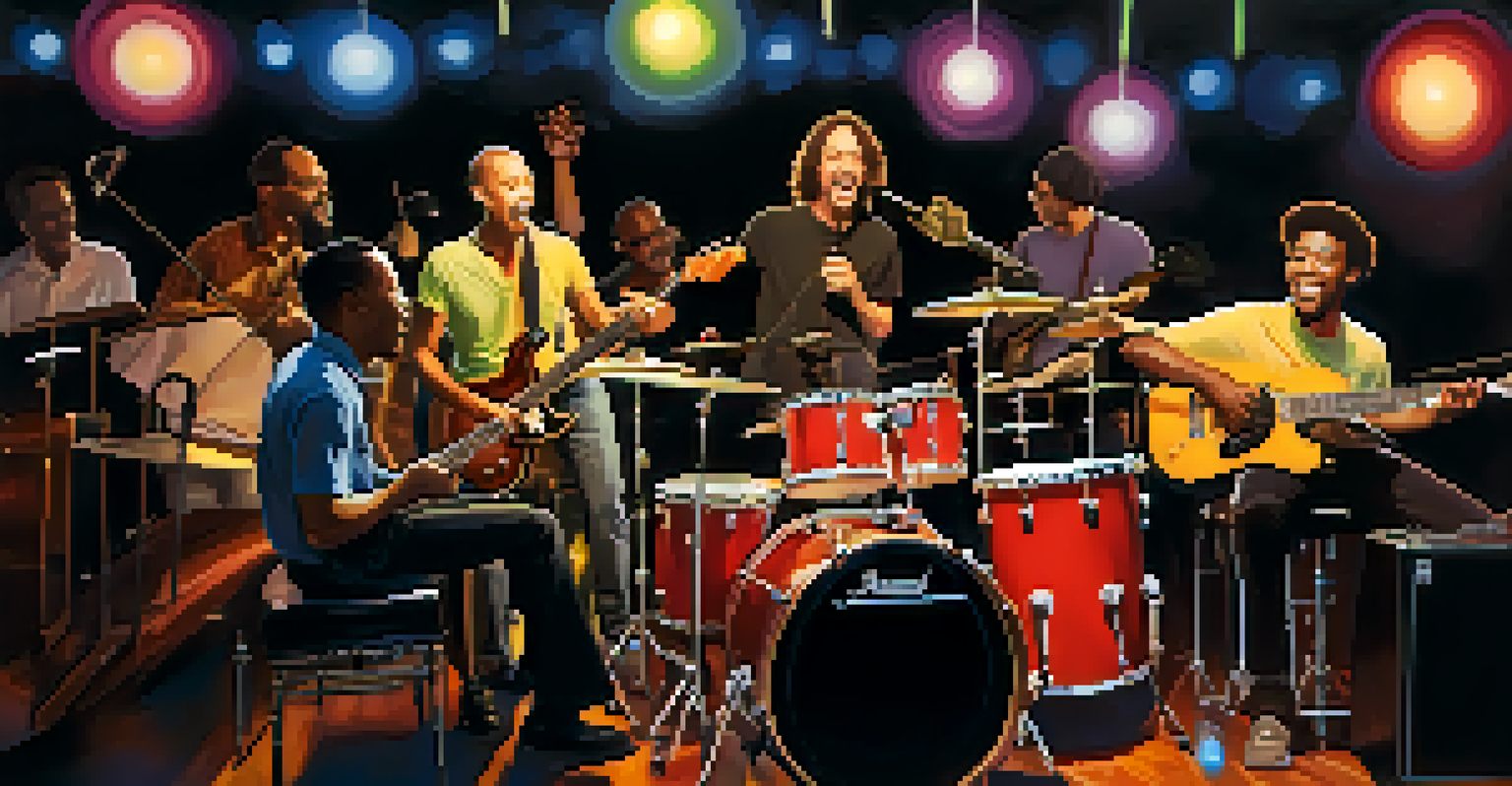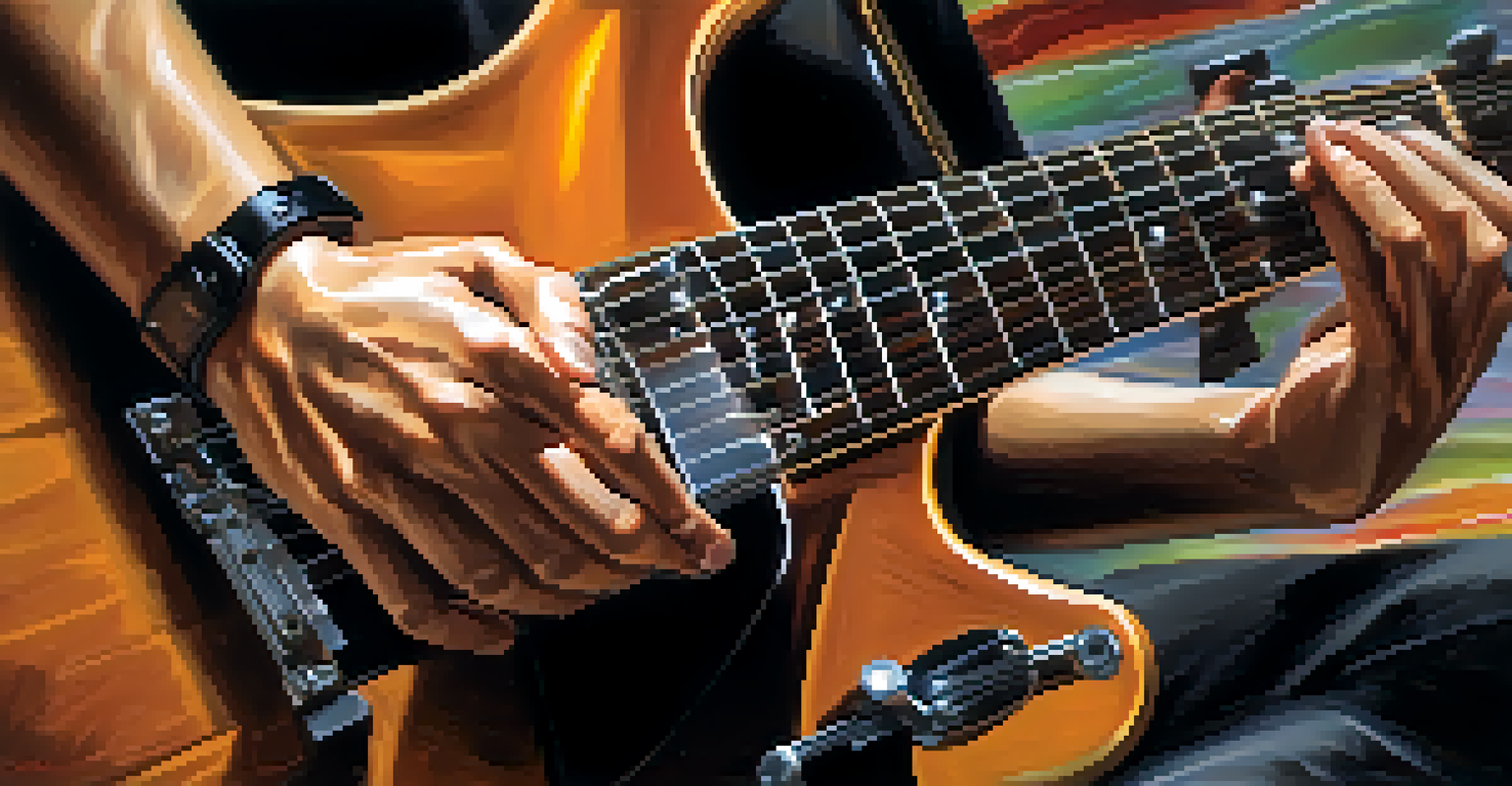Improvisation Techniques for Dynamic Guitar Performances

Understanding the Basics of Guitar Improvisation
Improvisation is the art of creating music spontaneously, and it can be a thrilling experience for any guitarist. At its core, it involves understanding scales, chords, and how they interact. By familiarizing yourself with the major and minor scales, you can start to weave melodies that resonate with your audience.
Improvisation is the ability to create something original and spontaneous in the moment.
Think of it like having a conversation; the more vocabulary you know, the richer your dialogue will be. For guitarists, this means having a solid grasp of various scales as well as the harmonic context of the song you’re playing. This foundation allows you to express your musical ideas freely.
As you dive deeper into improvisation, remember that practice is key. Jam along with backing tracks or fellow musicians to develop your skills in real-time. The more you practice, the more comfortable you’ll become with spontaneous musical expression.
Developing Your Ear for Improvisation
A strong musical ear can elevate your improvisational skills significantly. Training your ear allows you to recognize chord progressions and melodies, making it easier to respond musically in the moment. This skill is like learning a new language; the more you listen, the more fluent you'll become.

One effective way to develop your ear is through active listening. Try to identify melodies and chords in your favorite songs, and then replicate them on your guitar. This practice helps you internalize different musical phrases and styles, enriching your improvisational toolkit.
Develop Your Musical Ear
Training your ear to recognize melodies and chords enhances your ability to improvise spontaneously.
Additionally, consider ear training apps or exercises that challenge your ability to identify intervals and chords. Over time, you’ll find that your ability to improvise becomes more intuitive, allowing you to connect emotionally with your audience during performances.
Exploring Different Musical Styles for Inspiration
Improvisation isn’t confined to one genre; it thrives on diversity. Exploring different musical styles, like jazz, blues, rock, or classical, can provide fresh ideas for your guitar solos. Each genre has its own unique characteristics that can inspire new ways to express yourself on the guitar.
Mistakes are the portals of discovery.
For example, jazz improvisation often involves complex chords and syncopated rhythms, while blues tends to focus on emotion and simplicity. By incorporating elements from various styles into your playing, you can create a richer and more dynamic improvisational palette.
Don’t hesitate to experiment with incorporating techniques from different genres into your performances. Even a small twist, like using a blues scale in a rock context, can lead to exciting and unexpected results that captivate your audience.
Utilizing Scale Patterns to Enhance Your Solos
Scale patterns are valuable tools for improvisation, and they can add depth to your solos. By practicing scale shapes and sequences, you can develop fluidity and speed in your playing. These patterns serve as a roadmap, guiding your fingers across the fretboard during improvisation.
One effective method is to practice scales in different positions on the neck. For instance, you can start with the pentatonic scale and explore how it sounds in various keys. This not only enhances your technical ability but also helps you understand how to navigate the fretboard more confidently.
Embrace Mistakes in Music
Viewing mistakes as opportunities for creativity can lead to unique musical expressions during improvisation.
Incorporate these patterns into your improvisation by combining them with your musical ideas. As you become more comfortable with these scales, you’ll find it easier to create engaging solos that resonate with your audience, making your performances unforgettable.
Incorporating Rhythm and Timing in Improvisation
Rhythm is just as crucial as melody in improvisation. A well-timed note can evoke powerful emotions, while a rushed or misplaced one can disrupt the flow of your performance. Understanding rhythmic patterns and how to play them can greatly enhance your improvisational skills.
Try experimenting with different rhythms by playing along to a metronome or drum backing track. This practice can help you develop a sense of timing and groove, allowing you to play more expressively. Consider varying your note durations and adding syncopation to create more interest in your solos.
Remember, improvisation is about feel, and sometimes it’s the nuances in rhythm that create the most memorable moments. By mastering the interplay of rhythm and melody, you’ll be able to take your guitar performances to new heights.
Embracing Mistakes as Part of the Process
Every musician makes mistakes, especially during improvisation. Instead of fearing errors, embrace them! Often, what feels like a mistake can lead to unexpected musical ideas that you might not have explored otherwise. Think of it as an opportunity for creativity rather than a setback.
For instance, if you hit a wrong note, try to incorporate it into your solo. You might discover that by bending or sliding into it, you create a unique sound that adds depth to your performance. This mindset shift can transform your approach to improvisation, making it more enjoyable and less stressful.
Master Scales for Improvisation
Understanding major and minor scales is essential for guitarists to express their musical ideas freely.
Remember, improvisation is about self-expression, and authenticity often shines through imperfections. By allowing yourself to make mistakes, you give yourself the freedom to explore new musical territories and connect more deeply with your audience.
Practicing Improvisation with Others
One of the best ways to refine your improvisational skills is by playing with others. Collaborative jam sessions can introduce you to new ideas, styles, and techniques that you may not encounter when practicing alone. It’s like a musical conversation where everyone brings their own voice to the table.
Playing with different musicians can also help you adapt to various playing styles and genres. This adaptability is crucial for improvisation, allowing you to think on your feet and respond to the music around you. Plus, the energy of a group can be incredibly inspiring and motivating.

Don’t be afraid to seek out local jam sessions or online collaborations. The experience you gain from interacting with other musicians will not only improve your improvisation but also create lasting connections within the music community.